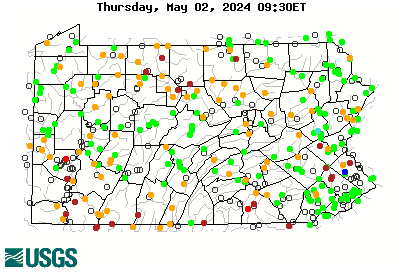So that means that the baselines used to establish our brook trout inventory are likely overinflated
If a stream is 99% brookies and 1% browns, it's a brook trout stream. It shouldn't be excluded from the inventory. And it isn't lost. The inventory sees these as "degraded", but I don't think that's the case at all. I can't hold a straight face and say that the rare brown trout in such places is in any way holding down the brook trout population. Jeans was mentioned here, it's just a stand in for 2000 other brook trout streams. Does anyone really think the brookie population is unhealthy there? They're big, healthy well fed fish, and on a bad day you can catch 40, on a good day you can net 100, all age classes, and every single little pool has a bunch of them. There's virtually nil siltation, the entire stream is scree, half the flow is underground, and there's solid holding water in both droughts and floods, and it's mostly on protected public land. So 1 in 500 fish or so is a brown. It remains brookies despite that, brookies are WINNING! That's gold Jerry. Gold!
There's value in protecting the brook trout holdout, that's on the precipice of flipping to browns. The ones in high danger, that "want" to become brown trout streams, and where any little hiccup will end in that outcome. Absolutely. And that may involve removal in some instances, erecting barriers, etc. But our long term outlook is probably NOT good in those places. You gotta try.
On the other ones. And this is the MAJORITY. Where brown trout already exist but the stream remains dominated by brookies anyway. Streams that "want" to be brook trout streams. IMO, these streams are just as, if not more valuable. They're resilient. The presence of browns has been there for 50-100 years and yet the brookies continue to thrive. For the long term outlook of brook trout, these are your gold. The conservation focus has to be a little different. Instead of focusing on barring entry to brown trout, removing any brown trout that are present. We should instead pay attention to what makes them brook trout habitat, and keep it that way. Siltation, pH, gradient, temperature, forest type, groundwater (which is naturally limited in many, but still far better than yards or parking lots). In the case of pH and alkalinity, even what is normally viewed as improvement could be detrimental, we need to be mindful of that. As far as threats. Land use and urbanization. Drilling (mostly due to the surface disturbance of building pads, I think). Logging practices. Hemlock Woolly Adelgid.
That's why I didn't like the 4th down and punt analogy. On removal of browns, barring entry, making them 100% allopatric. Yes, on most of them, punt. But does that mean to give up on the stream? Absolutely not. Those are your most important ones. The money in the bank. Protect the streams!!! And you'll find lots of help from the "brown trout people." Aside from the fact that they want to see brookies continue to thrive too, those are also the waterways that feed the brown trout streams.





